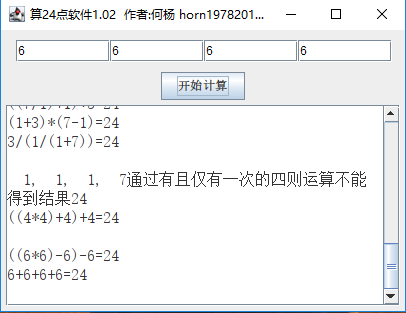算24点是一种挺好的锻炼孩子算数能力的扑克牌游戏,它的游戏方式是把四张牌的牌面数值通过有限四则运算得到结果24,四张牌必须仅用一次。各地玩法还有点差别,有的只算1-10,其它抽出来;有的地方把整幅牌都算上,把其中J当作11,Q当作12,K当作13,小王当作15,大王当作18. 个人觉得后者不但省了理牌的功夫还更能锻炼人。
算24也是有窍门的,那就是逐步缩小范围,具体来说是看三个数运算能否和第四个数通过加减乘除得到24,继而看三个数操作能否得到24和第四个数的四则运算结果,继而看两个数的操作能否得到第三个数和上次结果的四则运算结果。具体比如有2,3,4,12四个数,看到12后想2,3,4是否能组合个2出来,然后想到2*3-4的方案,或者2*(4-3)的方案。
绝大多数四张牌的组合都容易算出来,有部分就要费点脑筋了,如5,5,5,1;3,7,3,7;12,12,12,10...,当然也有完全算不出来的,如5,7,8,11;1,1,6,11...从规律上讲,似乎5,7,11,13这样的素数参与越多越是难算. 如果您不确定四张牌能否算出24时,本软件正好能帮您解惑。
源码及执行包下载:https://files.cnblogs.com/files/heyang78/tweentyfour_bat_jar_src_210815pm.rar
码云地址:https://gitee.com/heyang78/twentyfour.git
使用前提:安装JDK1.8,若不会请参考 https://www.cnblogs.com/heyang78/p/7429783.html
使用方法:解压后双击run.bat执行
功能:提供四个正整数的计算24点的方案
界面截图:

目前瑕疵:得到的方案里有重复,要解决两个算式是否同构算式的问题。
核心的五个类如下,相对于《Java常用算法手册》P444的方案,我觉得本作更清晰、五个类分工更明确,更何况此方案是完全自我胸中所出,并非随人脚后行!
Caculater类:
package com.hy.art; import java.util.ArrayList; import java.util.Collections; import java.util.HashSet; import java.util.List; import java.util.Set; /** * 用于计算24的对外类 * @author 何杨 horn19782016@163.com * @version 创建时间:2021年8月14日 下午11:48:21 */ public class Caculater { private double op1; private double op2; private double op3; private double op4; private final double Result=24; public Caculater(double op1,double op2,double op3,double op4) { this.op1=op1; this.op2=op2; this.op3=op3; this.op4=op4; } public Caculater(double[] arr) { this.op1=arr[0]; this.op2=arr[1]; this.op3=arr[2]; this.op4=arr[3]; } public List<String> findWays(){ Set<String> ways=new HashSet<String>(); C4 c4=new C4(this.op1,this.op2,this.op3,this.op4,Result); List<String> ls=c4.findWays(); for(String line:ls) { line=line.replaceAll("((\d+)[.][0])", "$2"); ways.add(line); } List<String> retval=new ArrayList<String>(); retval.addAll(ways); Collections.sort(retval); return retval; } public static void main(String[] args) { Caculater c=new Caculater(12,6,4,1); List<String> ways=c.findWays(); if(ways.size()>0) { for(String way:ways) { System.out.println(way); } }else { System.out.println("No way"); } } }
C4类:
package com.hy.art; import java.util.ArrayList; import java.util.List; //====================================================== // C4类,用于判断三个数通过加减乘除运算能否得到某个结果 // C代表Caculate,4代表两个操作数 // op1:操作数1,op2:操作数2,op3:操作数3,op4:操作数4,result,结果 //====================================================== public class C4 { private double op1; private double op2; private double op3; private double op4; private double result; public C4(double op1,double op2,double op3,double op4,double result) { this.op1=op1; this.op2=op2; this.op3=op3; this.op4=op4; this.result=result; } public List<String> findWays(){ List<String> ways=new ArrayList<String>(); // 全排列数组,四个操作数共有24种排列方式 double[][] permutationArr={ {this.op1,this.op2,this.op3,this.op4}, {this.op1,this.op2,this.op4,this.op3}, {this.op1,this.op3,this.op2,this.op4}, {this.op1,this.op3,this.op4,this.op2}, {this.op1,this.op4,this.op2,this.op3}, {this.op1,this.op4,this.op3,this.op2}, {this.op2,this.op1,this.op3,this.op4}, {this.op2,this.op1,this.op4,this.op3}, {this.op2,this.op3,this.op1,this.op4}, {this.op2,this.op3,this.op4,this.op1}, {this.op2,this.op4,this.op1,this.op3}, {this.op2,this.op4,this.op3,this.op1}, {this.op3,this.op1,this.op2,this.op4}, {this.op3,this.op1,this.op4,this.op2}, {this.op3,this.op2,this.op1,this.op4}, {this.op3,this.op2,this.op4,this.op1}, {this.op3,this.op4,this.op1,this.op2}, {this.op3,this.op4,this.op2,this.op1}, {this.op4,this.op1,this.op2,this.op3}, {this.op4,this.op1,this.op3,this.op2}, {this.op4,this.op2,this.op1,this.op3}, {this.op4,this.op2,this.op3,this.op1}, {this.op4,this.op3,this.op1,this.op2}, {this.op4,this.op3,this.op2,this.op1}, }; for(int i=0;i<permutationArr.length;i++) { double[] innerArr=permutationArr[i]; double oprand1=innerArr[0]; double oprand2=innerArr[1]; double oprand3=innerArr[2]; double oprand4=innerArr[3]; // [op1,op2,op3]-op4 C3 c3=new C3(oprand1,oprand2,oprand3,this.result+oprand4); List<String> c3Ways=c3.findWays(); for(String c3Way:c3Ways){ ways.add('('+c3Way+")"+"-"+oprand4); } // [op1,op2,op3]/op4 c3=new C3(oprand1,oprand2,oprand3,this.result*oprand4); c3Ways=c3.findWays(); for(String c3Way:c3Ways){ ways.add('('+c3Way+")"+"/"+oprand4); } // [op1,op2,op3]+op4 c3=new C3(oprand1,oprand2,oprand3,this.result-oprand4); c3Ways=c3.findWays(); for(String c3Way:c3Ways){ ways.add('('+c3Way+")"+"+"+oprand4); } // op4-[op1,op2,op3] c3=new C3(oprand1,oprand2,oprand3,oprand4-this.result); c3Ways=c3.findWays(); for(String c3Way:c3Ways){ ways.add(oprand4+"-"+'('+c3Way+")"); } // [op1,op2,op3]*op4 c3=new C3(oprand1,oprand2,oprand3,this.result/oprand4); c3Ways=c3.findWays(); for(String c3Way:c3Ways){ ways.add('('+c3Way+")"+"*"+oprand4); } // op4/[op1,op2,op3] c3=new C3(oprand1,oprand2,oprand3,oprand4/this.result); c3Ways=c3.findWays(); for(String c3Way:c3Ways){ ways.add(oprand4+"/"+'('+c3Way+")"); } // 以下为C4中特有的先成对组合再看运算结果 // 1 if(isEqual(oprand1*oprand2-oprand3*oprand4,result)){ ways.add(oprand1+"*"+oprand2+"-"+oprand3+"*"+oprand4); } // 2 if(isEqual(oprand1*oprand2+oprand3*oprand4,result)){ ways.add(oprand1+"*"+oprand2+"+"+oprand3+"*"+oprand4); } // 3 if(isEqual(oprand1/oprand2-oprand3/oprand4,result)){ ways.add(oprand1+"/"+oprand2+"-"+oprand3+"/"+oprand4); } // 4 if(isEqual(oprand1/oprand2+oprand3/oprand4,result)){ ways.add(oprand1+"/"+oprand2+"+"+oprand3+"/"+oprand4); } // 5 if(isEqual(oprand1*oprand2-oprand3/oprand4,result)){ ways.add(oprand1+"*"+oprand2+"-"+oprand3+"/"+oprand4); } // 6 if(isEqual(oprand1*oprand2+oprand3/oprand4,result)){ ways.add(oprand1+"*"+oprand2+"+"+oprand3+"/"+oprand4); } // 7 if(isEqual((oprand1+oprand2)*(oprand3-oprand4),result)){ ways.add("("+oprand1+"+"+oprand2+")*("+oprand3+"-"+oprand4+")"); } // 8 if(isEqual((oprand1+oprand2)/(oprand3-oprand4),result)){ ways.add("("+oprand1+"+"+oprand2+")/("+oprand3+"-"+oprand4+")"); } // 9 if(isEqual((oprand1-oprand2)*(oprand3-oprand4),result)){ ways.add("("+oprand1+"-"+oprand2+")*("+oprand3+"-"+oprand4+")"); } // 10 if(isEqual((oprand1-oprand2)/(oprand3-oprand4),result)){ ways.add("("+oprand1+"-"+oprand2+")/("+oprand3+"-"+oprand4+")"); } // 11 if(isEqual((oprand1+oprand2)*(oprand3+oprand4),result)){ ways.add("("+oprand1+"+"+oprand2+")*("+oprand3+"+"+oprand4+")"); } // 12 if(isEqual((oprand1+oprand2)/(oprand3+oprand4),result)){ ways.add("("+oprand1+"+"+oprand2+")/("+oprand3+"+"+oprand4+")"); } } return ways; } // 判断两个double数是否相等 private static boolean isEqual(double d1,double d2){ return Math.abs(d1-d2)<0.0001; } public static void main(String[] args) { C4 c4=new C4(2,4,6,8,24); List<String> ls=c4.findWays(); if(ls.size()>0) { for(String line:ls) { System.out.println(line); } }else { System.out.println("No way."); } } }
C3类:
package com.hy.art; import java.util.ArrayList; import java.util.List; //====================================================== // C3类,用于判断三个数通过加减乘除运算能否得到某个结果 // C代表Caculate,3代表三个操作数 // op1:操作数1,op2:操作数2,op3:操作数3,result,结果 //====================================================== public class C3 { private double op1; private double op2; private double op3; private double result; public C3(double op1,double op2,double op3,double result) { this.op1=op1; this.op2=op2; this.op3=op3; this.result=result; } public List<String> findWays(){ List<String> ways=new ArrayList<String>(); // 排列数组,三个操作数共有6种排列方式 double[][] permutationArr= { {this.op1,this.op2,this.op3}, {this.op1,this.op3,this.op2}, {this.op2,this.op1,this.op3}, {this.op2,this.op3,this.op1}, {this.op3,this.op2,this.op1}, {this.op3,this.op1,this.op2}, }; for(int i=0;i<permutationArr.length;i++) { double[] innerArr=permutationArr[i]; double oprand1=innerArr[0]; double oprand2=innerArr[1]; double oprand3=innerArr[2]; // [op1,op2]-op3 C2 c2=new C2(oprand1,oprand2,this.result+oprand3); List<String> c2Ways=c2.findWays(); for(String c2Way:c2Ways){ ways.add('('+c2Way+")"+"-"+oprand3); } // [op1,op2]/op3 c2=new C2(oprand1,oprand2,this.result*oprand3); c2Ways=c2.findWays(); for(String c2Way:c2Ways){ ways.add('('+c2Way+")"+"/"+oprand3); } // [op1,op2]+op3 c2=new C2(oprand1,oprand2,this.result-oprand3); c2Ways=c2.findWays(); for(String c2Way:c2Ways){ ways.add('('+c2Way+")"+"+"+oprand3); } // op3-[op1,op2] c2=new C2(oprand1,oprand2,oprand3-this.result); c2Ways=c2.findWays(); for(String c2Way:c2Ways){ ways.add(oprand3+"-"+'('+c2Way+")"); } // [op1,op2]*op3 c2=new C2(oprand1,oprand2,this.result/oprand3); c2Ways=c2.findWays(); for(String c2Way:c2Ways){ ways.add('('+c2Way+")"+"*"+oprand3); } // op3/[op1,op2] c2=new C2(oprand1,oprand2,oprand3/this.result); c2Ways=c2.findWays(); for(String c2Way:c2Ways){ ways.add(oprand3+"/"+'('+c2Way+")"); } } return ways; } }
C2类:
package com.hy.art; import java.util.ArrayList; import java.util.List; /** * // C2类,用于判断两个数通过加减乘除运算能否得到某个结果 // C代表Caculate,2代表两个操作数 // op1:操作数1,op2:操作数2,result,结果 * @author 何杨 horn19782016@163.com * @version 创建时间:2021年8月14日 下午10:55:57 */ public class C2 { private double op1; private double op2; private double result; public C2(double op1,double op2,double result) { this.op1=op1; this.op2=op2; this.result=result; } public List<String> findWays(){ List<String> ways=new ArrayList<String>(); // 加一种 if(isEqual(result,(op1+op2))) { ways.add(op1+"+"+op2); } // 乘一种 if(isEqual(result,(op1*op2))) { ways.add(op1+"*"+op2); } // 减两种 if(isEqual(result,(op1-op2))) { ways.add(op1+"-"+op2); } if(isEqual(result,(op2-op1))) { ways.add(op2+"-"+op1); } // 除两种 if(isEqual(result,(op1/op2))) { ways.add(op1+"/"+op2); } if(isEqual(result,(op2/op1))) { ways.add(op2+"/"+op1); } return ways; } // 判断两个double数是否相等 private static boolean isEqual(double d1,double d2){ return Math.abs(d1-d2)<0.0001; } }
-END-